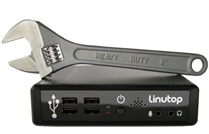Tutorials/Debootstrap
From LinutopWiki
Contents |
Build a custom debian/ubuntu based system for your Linutop
The OS provided with your Linutop is a LiveCD-like system, which means that you can't modify it easily. But you can easily create your own Linux system. All you need is a working installed debian/ubuntu system, and a minimal knowledge about how to use it (mainly how to install packages).
For this tutorial, we will create a minimal Ubuntu Hardy system, using the system as host.
Preparing
The first thing to do is to create partitions on the USB stick/Hard drive on which you want to install your system. There's no pre-defined rule for this, you'll have to partition your disk so that it fits your needs.
To partition your disk, use your favourite partition software (parted, qtparted, gparted, partition magic...). In our example we will use a single partition for the entire system, plus a swap partition.
Once your partitions are set up, mount the future root partition on your running debian/ubuntu system:
$ CHROOT=/media/usb $ sudo mkdir $CHROOT $ sudo mount /dev/sda1 $CHROOT # change /dev/sda1 to the device you'll use
We can now create the minimal system using debootstrap:
$ sudo apt-get install debootstrap $ sudo debootstrap hardy $CHROOT
Debootstrap will now download and install a minimal but usable system on your disk. Let's prepare some tea now...
Making the new system bootable
You can now use the system by chrooting in it:
$ sudo chroot $CHROOT $ cat /etc/lsb-release # we are in the new system $ exit
But you can't boot this system because:
- There's no kernel to boot (chroot uses your host system kernel)
- There's no boot loader (such as grub or lilo)
Setting up apt
Let's update the chroot sources.list:
$ sudo vim $CHROOT/etc/apt/sources.list # use your favorite text editor instead of vim
Modify the file to have:
deb http://archive.ubuntu.com/ubuntu hardy main restricted universe multiverse deb http://archive.ubuntu.com/ubuntu hardy-updates main restricted universe multiverse deb http://archive.ubuntu.com/ubuntu hardy-security main restricted universe multiverse
Now in the chroot:
# apt-get update # we are root in the chroot, no need to use sudo # apt-get dist-upgrade # to get the updates installed
If the system asks you question and you don't know what to do, just use the default answers.
Installing a kernel and a boot loader
We still are in the chroot:
# apt-get install linux-headers-generic linux-restricted-modules-generic linux-restricted-modules-generic # apt-get install linux-image-generic
Now we install grub:
# apt-get install grub # mkdir /boot/grub # update-grub # vim /boot/grub/menu.lst
Edit the two entries at the bottom of /boot/grub/menu.lst; you only need to replace /dev/hda1 with /dev/sda1. The entries will look something look like this:
timeout 10 title Ubuntu, kernel 2.6.17-11-generic root (hd0,0) kernel /boot/vmlinuz-2.6.17-11-generic root=/dev/sda1 ro quiet initrd /boot/initrd.img-2.6.17-11-generic quiet savedefault
We'll install the boot record outside of the chroot:
# exit
Now install grub on the MBR:
$ sudo grub-install --root-directory=$CHROOT --no-floppy --recheck /dev/sdb # modify /dev/sdb to use your device
Now umount your disk:
# sudo umount $CHROOT
Linutop2 and Ubuntu Hardy
The Linutop2 has internally 1GB of flash. It may be that your USB-key is used to boot, but during the "initramfs" phase the Linutop2 flash is mounted and you get an error about /sbin/init not existing.
Tricky because we see that /dev contains entries for sda but not for sdb and the directory /root/ looks nothing like what's on your USB key (it's actually the image on the 1GB Linutop2 Flash).
The most reliable way (tested on Hardy 8.04.1 as the USB key image) is to label the USB key (with e2label) and modify grub's menu.lst file to boot from a labelled partition.
- Label the USB key. Assume it's mounted on your build environment as /dev/sdb1
- Modify the grub /boot/grub/menu.lst file so the boot section looks something like this
# e2label /dev/sdb1 mylinukey
title Ubuntu 8.04.1, kernel 2.6.24-19-generic root (hd0,0) kernel /boot/vmlinuz-2.6.24-19-generic root=LABEL=mylinukey ro initrd /boot/initrd.img-2.6.24-19-generic
Only use the letters [a-zA-Z] in your label. Other characters may prevent your USB key from starting correctly.
Configuration
Root password
Inside the chroot:
# passwd
Type your password twice.
Setting up network
Add default network entries inside the chroot:
# vim /etc/network/interfaces
The content could look like this:
auto lo iface lo inet loopback auto eth0 iface eth0 inet dhcp
Time and date
Set the timezone (match the zoneinfo to match your location):
# mv /etc/localtime /etc/localtime.dist # ln -s /usr/share/zoneinfo/Europe/Oslo /etc/localtime
Add users
# adduser myusername
Sudo
If you're used to Ubuntu systems, you might want to set up sudo. Inside the chroot:
# apt-get install sudo # addgroup admin # adduser myusername admin # use your user login instead of 'myusername' # echo "%admin ALL=(ALL) ALL" >> /etc/sudoers
You'll be able to use sudo when logged in with your main user.
This is it!
You're done! Connect the usb drive to your Linutop and boot it. The default password for root is blank.
The installed system is *really* minimalist and you'll have to set up several things (configure, install packages...)
Quick guide to make our system more pleasant
After booting your new system probably you would like to watch some movie in graphic environment than live in console. Linutop is not the fastest machine available on the market so I advise you to install some lightweight solutions.
Audio drivers: # apt-get install linux-ubuntu-modules-$(uname -r)
Video drivers: # apt-get install xorg
Display manager: # apt-get install xdm
Desktop environment: # apt-get install fluxbox
3rd party software: # apt-get install mplayer firefox openoffice.org leafpad nano gnome-terminal aumix xchat gftp

